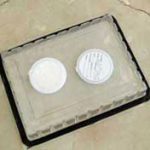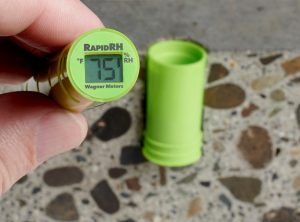3 Ways to Guarantee a Concrete Roofing Application Failure
Moisture-related problems are just as real in the commercial roofing industry as they are in the flooring industry. Moisture can cause roofing systems to degrade, lose adhesion, develop mold growth, curl, and even lead to total system failure. The risks of ignoring the moisture conditions of the concrete deck can be costly.
What practices can put your concrete roofing application at risk?
1. Forget (or ignore) the drying process of concrete.
Moisture levels in any concrete slab are affected by a number of conditions including air movement, ambient and internal temperature, admixture components, and the amount of water in the original batch pour. However, even though each job site will have variations, the process by which concrete dries is unchanging.
In order for the concrete to dry after curing is complete, moisture must make its way to the surface by means of the various small air voids that form a capillary network through the slab. Just like a traffic bottleneck releases more slowly the further back you are, the moisture in the slab will be more densely collected further into the slab, forming a sort of gradient effect of moisture levels.
Why is that significant?
Because the conditions at the surface of the slab will not reflect the moisture throughout the slab at any point in the drying process. While the surface will generally be drier than the interior, those pores in the concrete can, in fact, even allow moisture to re-enter the slab if the ambient conditions have a higher relative humidity than the internal conditions of the slab.
If ambient conditions change over the course of the time scheduled for the concrete deck to dry (and let’s face it, they are rarely ideal for the duration of the job), the “formula” for the time required to reach its readiness for subsequent roofing materials will also be changed.
2. Use a surface-based test method.
Just as in other industries, roofing professionals have often been trained with non-scientific or traditional methods in determining when the concrete is dry enough to continue with the roofing application.
 For example, the plastic sheet method consists of taping a plastic sheet to the concrete deck’s surface and then later examining it for condensation as an indication of the concrete’s moisture content. It is, of course, a non-quantifiable result – there’s no measurement of the amount of condensation and no established correlation between the absence or presence of condensation and what the internal moisture content of the slab might be.
For example, the plastic sheet method consists of taping a plastic sheet to the concrete deck’s surface and then later examining it for condensation as an indication of the concrete’s moisture content. It is, of course, a non-quantifiable result – there’s no measurement of the amount of condensation and no established correlation between the absence or presence of condensation and what the internal moisture content of the slab might be.
Unfortunately, no surface-based test method – plastic sheet, hood, moisture meter, MVER or CaCl, hot mopping bitumen, or visual assessment – can accurately measure moisture content to determine the deck’s readiness for the specified roofing materials.
3. Ignore the moisture tolerance of the roofing materials.
In the last century, building materials were consistently more moisture tolerant than those being used in modern-day construction. So, a continuous layer of bituminous adhesive also acted as a vapor retarder over an insulation system that was significantly more moisture-resistant than its modern counterparts. The end result was a roof system much less susceptible to moisture intrusion.
In today’s building industry, changes in regulations intended to limit volatile organic compounds (VOCs) has also meant that the moisture tolerance of many products is highly variable. Whether that’s a moisture-sensitive paper face on the insulation board or an adhesive layer with lower moisture tolerance, if the concrete deck’s moisture level does not fall within the tolerance range of every component of the roofing system, the entire roof will be at risk.
Vapor barriers provide a necessary level of protection if their perm rates are sufficient to the job site, but once moisture begins to penetrate any layer of the roofing system, other natural processes like freeze-thaw cycles or mold growth will begin to degrade the roof as a whole.
Is there a solution?
A number of possibilities are being explored, including continued development of building products that are more resistant to moisture intrusion, and hygrothermal computer modeling has provided the basis for studying different test scenarios. The challenges of roofing applications are unique and highly variable based on climate, concrete mixtures and the design of each roofing system.
One possibility that has been examined with interest is the advantage of relative humidity (RH) testing for roofing applications. We believe it holds great promise today for providing roofing experts with the tools and technology they need to accurately determine when concrete decks are ready for roofing applications.
 Relative humidity testing, like the Rapid RH® L6, has been scientifically founded and proven to give accurate moisture content measurement for concrete in flooring systems and presents the most accurate test method for concrete systems in any application. The Rapid RH® L6 is the result of decades of research and collaboration with other industry experts to provide the building industry with tested, accurate, affordable solutions to the challenges of moisture-related problems. ASTM F2170 provides the guidelines for RH testing for flooring applications and demonstrates how RH testing provides intriguing possibilities for roofing applications as well.
Relative humidity testing, like the Rapid RH® L6, has been scientifically founded and proven to give accurate moisture content measurement for concrete in flooring systems and presents the most accurate test method for concrete systems in any application. The Rapid RH® L6 is the result of decades of research and collaboration with other industry experts to provide the building industry with tested, accurate, affordable solutions to the challenges of moisture-related problems. ASTM F2170 provides the guidelines for RH testing for flooring applications and demonstrates how RH testing provides intriguing possibilities for roofing applications as well.
